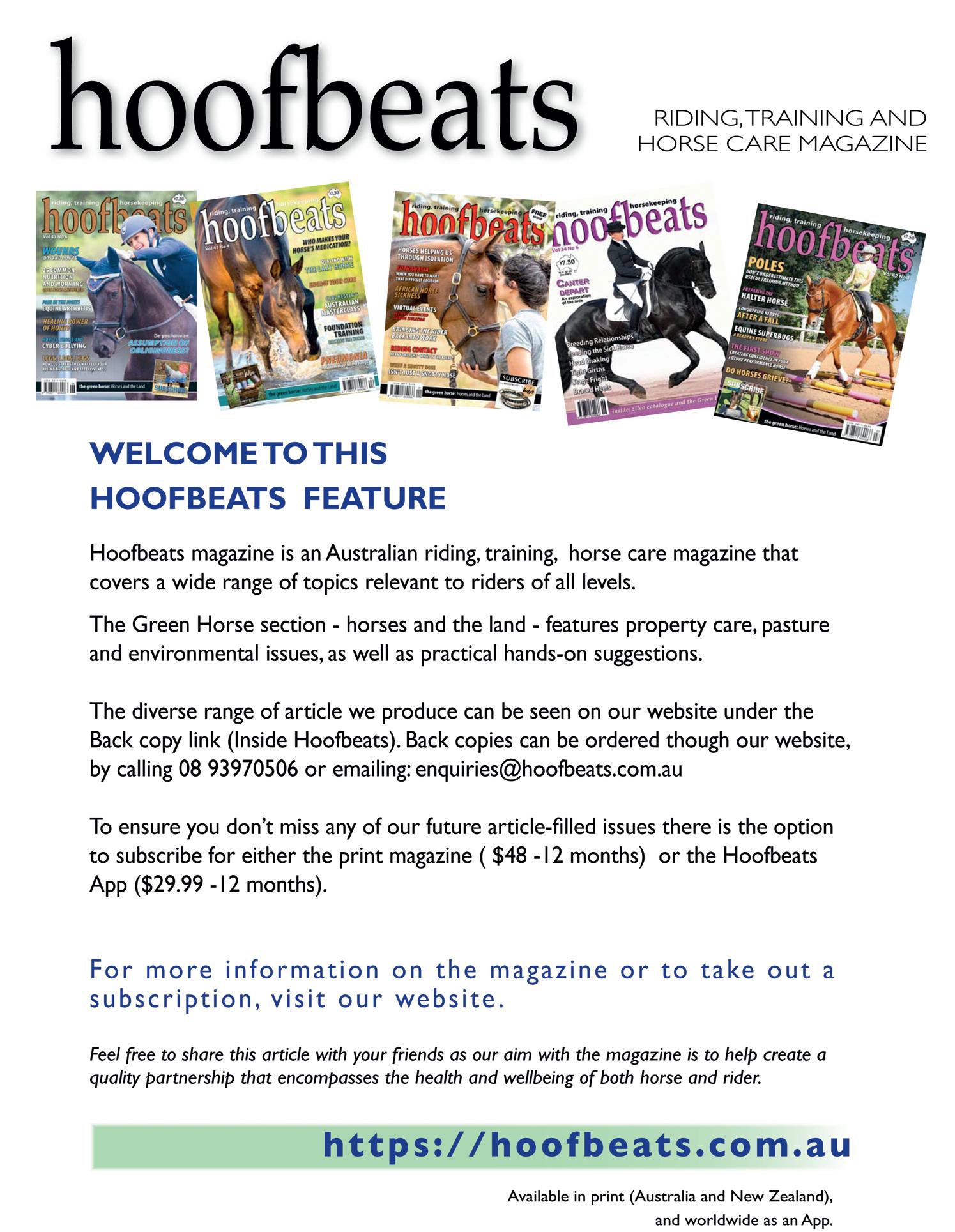Saddle Fit Fundamentals



clearance below). This is so that when the horse moves its front legs, the saddle does not restrict or interfere with the movement in any way; a common mistake made by riders/owners is positioning the saddle too far forward. The exception is the jumping saddle, which is cut so the flap extends forward of the shoulder blade in order to provide a more secure leg position.
be overwhelming, especially to those new to the sport, making it difficult to know where to start and what to focus on when choosing one!
In this article we go back to basics and take a look at what a well-fitted saddle should look like, recognise the detrimental effects that can occur from using a poorly fitted one, and discuss what options riders have if their saddle is missing the mark.
Before evaluating the fit of the saddle, the horse should be stood squarely and on level ground. Do not use a saddle pad or stirrup irons.
The following is relevant to both the English and Western saddle. When placed correctly, the saddle should be far enough back that the saddle flap (for English saddles) or the front of the bar of the saddle tree (for the Western saddle) is behind and clear of the horse’s shoulder (approximately 2-3 fingers’ width, as recommended for wither
Place the saddle gently on the horse’s back, just forward of the withers, and then slide it backwards slowly until it comes to a natural stop; repeat a few times until you are familiar with its position. Check the positioning of the billets - if they are positioned too far back the saddle will continuously be pulled forward as the horse moves even if it fits the horse relatively well, as the girth tends to seek the narrowest point of the trunk.
After assessing position, the next step is to check that the saddle is level – that is, that the pommel does not sit too much higher than the cantle, or vice versa, and that the lowest point of the seat is parallel to the ground. (Note that a dressage saddle by design will have a slightly higher cantle than a general purpose or jumping saddle.)
With Western saddles, which do not have panels, look at the bars of the tree which run between the pommel/swell and the cantle, they should follow the contour of the back, sitting flat on the back so as to distribute weight evenly. A level seat is important in ensuring that the rider’s position is correct and they are not putting
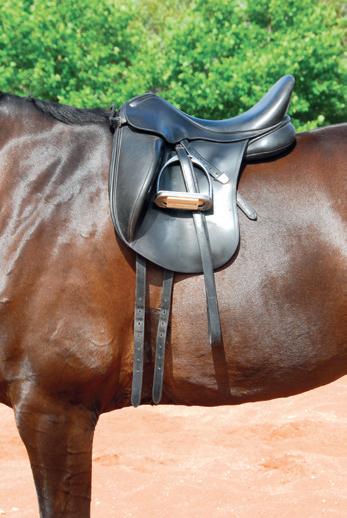
undue stress on the horse’s loin, hindering engagement of the hind limbs (seen when the seat is tipping back towards the cantle) or pitching forward over the withers, causing the points of the saddle to pinch the horse’s shoulder (seat tipping towards the pommel).
A level saddle also allows the rider to keep up with the horse’s movement as they are more likely to be balanced…which spares the rider’s back too! A correctly balanced saddle (English or Western) should not ‘rock’ forwards or backwards. To evaluate, when the saddle is on the horse, place one hand on the pommel/swell and the other on the cantle and press down first with one hand and then the other to check for any undesirable see-sawing.
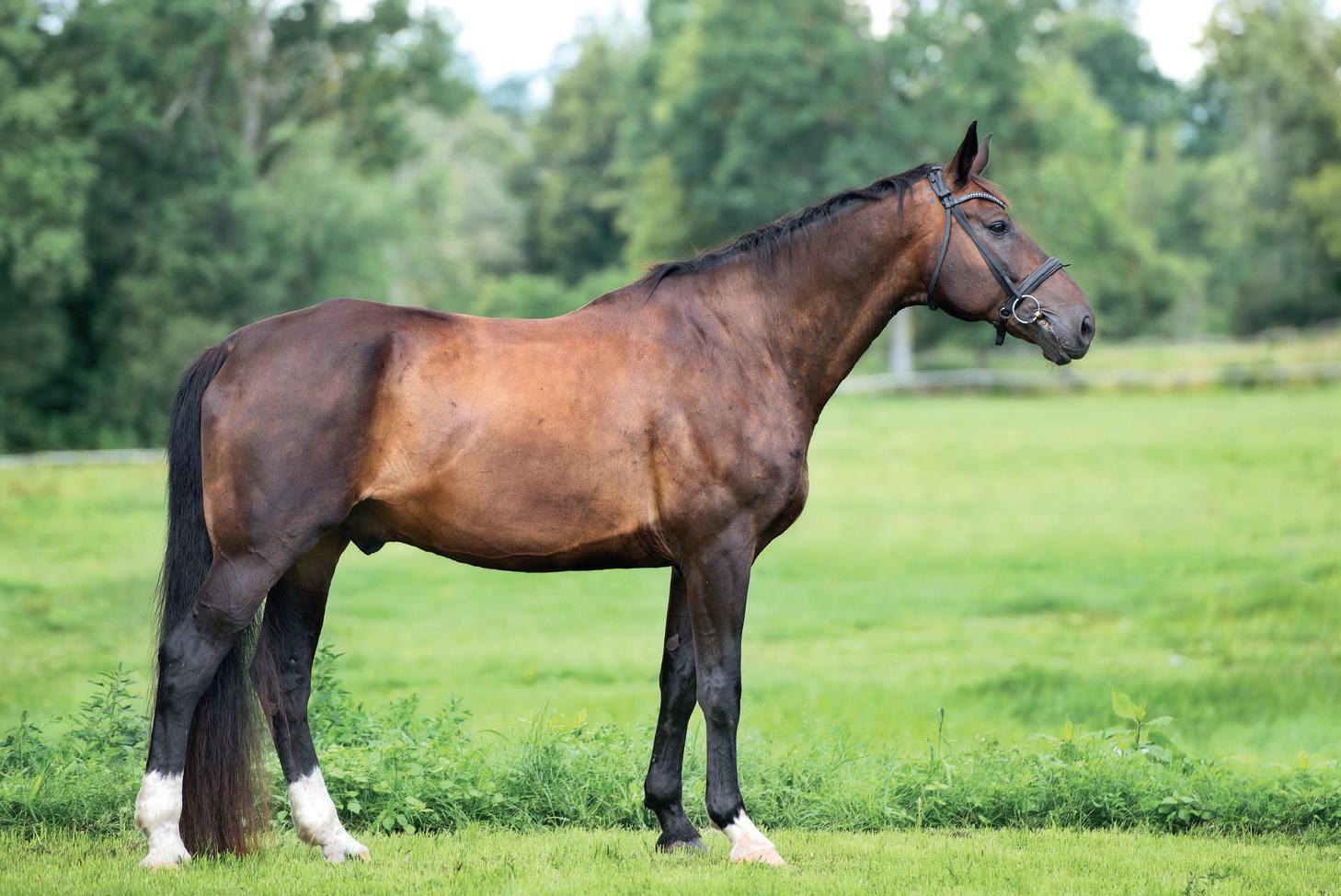
The age-old rule of thumb here is that there should be enough room to place 2-3 fingers in the gullet of the saddle – that is, between the underside of the pommel and the horse’s withers (the rider’s hand is positioned perpendicular to the withers). This allows for sufficient clearance once the rider is mounted and reduces the risk of the saddle pressing down onto the withers.
If there is not enough space, the saddle (tree) could be too wide; if there is too much space the saddle may be too narrow making it ‘perch’ on the withers. Stand behind the horse and observe the gullet as it runs along the back of the
The ‘channel’ between the saddle panels should clear the spine, with the saddle resting on the long back muscles. When ready to ride, and using a pad underneath the saddle, be sure to bring the pad up and into the gullet space so it is not stretched tightly across the horse’s withers and spinous processes.
Before delving into what constitutes a correctly fitted saddle it is important to be familiar with the basic names for the saddle parts. The diagrams below outline the various parts of the standard English and Western saddle: TREE – often made from laminated wood or synthetic materials in English saddles, or wood (covered with rawhide) or fibreglass in Western saddles, the tree is the ‘frame’ of the saddle that is subsequently covered in leather or, more recently, a synthetic leather-look fabric. The tree size defines both the saddle’s fit on the horse’s back and the size of the seat for the rider. Both English and Western saddles may be produced with flexible trees purported to increase comfort for the horse, others still are entirely treeless.
GULLET - the channel running down the centre of the saddle - on its underside - between the panels on an English saddle, or the bars of the Western saddle. Some saddles have changeable gullet systems to allow for changes in the fit of the saddle.
PANELS (English saddle) - the padded sections that run along either side of
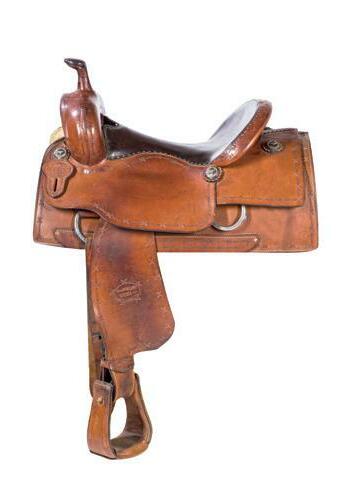
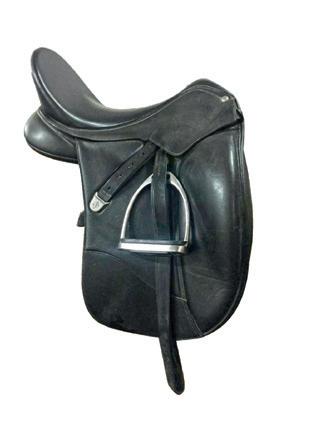
A saddle can be wide enough for the horse, but the angle of the tree may not be optimal, and this can cause problems. For the English saddle, the points of the tree can be found just in front of the billet straps. A western saddle tree will have two measurements: the width of the fork and the angle of the bars. Once the wither clearance has been determined, it is important to then assess where the tree points sit on the horse and whether the angle of the tree follows the angle of the shoulder. Only if this is the case can we be confident that the saddle clears not only the tops of the withers, but the sides too, and thus will not impinge on the horse’s shoulder muscles. For Western saddles it is slightly different, and the front and back sections of the bars are what need to be well-shaped and matched to the contours of the horse’s back. A good tree angle in an English saddle will be apparent if the edging on the front of the saddle (NOT the flocking underneath) looks to follow the angle of the shoulder. Look for gaps between the saddle and the musculature of the shoulder, or areas where there is compression – both of these

the gullet and which make contact with the horse’s back on either side of its spine. The panels are the weightbearing surfaces of the saddle and are stuffed (or ‘flocked’) with wool, air, gel or foam - which allows for some adjustment in saddle fit. Western saddles do not have panels, but rather the tree is lined underneath with sheepskin, wool or acrylic material.
SWEAT FLAP & SADDLE FLAP (English saddle) – the majority of English-style saddles have two flaps: the sweat flap that sits between the body of the horse and the (girth) billets, and the saddle flap which then sits on top of this, between the billets and the rider’s legs. There are some saddles that have just a single or ‘mono’ flap.
BILLETS – the straps to which the girth is buckled. The billets are anchored to the saddle’s tree via strong webbing.
would indicate the tree angle is incorrect for the horse’s conformation.
The point at which the last rib meets the spine marks the end of the horse’s weight-bearing (i.e. saddle + rider) area – beginning from just behind the withers. Loads applied farther back than here can cause pain, and damage to the horse’s muscles

A well-fitting English saddle will have panels that make even contact with the horse’s back, thus distributing the load of the rider over as much surface area as possible within the aforementioned weight-bearing region. When the contact between the panels and the horse’s back is not uniform it is known as ‘bridging’ and most often involves the front and back of the saddle panels touching the horse’s long back muscles, but not the centre, leading to differences in pressure Continued.
•
along the weight-bearing surface. This is of course undesirable and can lead to areas of soreness and muscle damage - sometimes permanent. To check for bridging, with the saddle on the horse’s back and no saddle pad, lay a hand flat underneath the sweat flap directly beneath the stirrup bar, where the panel meets the horse’s body, and run the fingertips backwards the length of the saddle, feeling for areas where the contact is different - or missing altogether. Repeat for both sides. Pay close attention to underneath the tree points to make sure they exert even pressure and are not digging into the shoulder.
These points should be assessed once again when the rider is mounted and the horse being worked, with the additional evaluation of how the horse is moving (restricted and shuffling or loose and forward going? Able to perform well-executed turns and school movements? Focused and responsive or lethargic and shut off?).
The are many, many signs of a poorly fitted saddle, including but not limited to:
Gel, foam, sheepskin…there is a staggering array of saddle pads and numnahs on offer, however contrary to popular belief, these are not a cure all for a badly fitted saddle! Studies have shown that whilst an ill-fitting saddle increases the forces on the horse’s back, few pads are able to reduce this or improve pressure distribution. Some may be useful in young horses to improve saddle fit as they grow.
Many English saddles are now designed with adjustable panels that can be re-flocked, or pumped up with air, to refine the fit to an individual horse/re-balance a saddle that has been used for a period of time (panels with wool flocking for example can compress overtime and become uneven). It is best for this to be done by a knowledgeable and experienced saddle fitter. Note that no amount of adjustment to the panels will get a saddle to the point of a perfect fit if the tree is the wrong size or angle; when it comes to flocking, the saddle must already be a pretty good fit everywhere else. There are saddles, both English and Western, that offer adjustable stirrup and girthing systems, modifiable seats and more. They of course come at a premium, but these
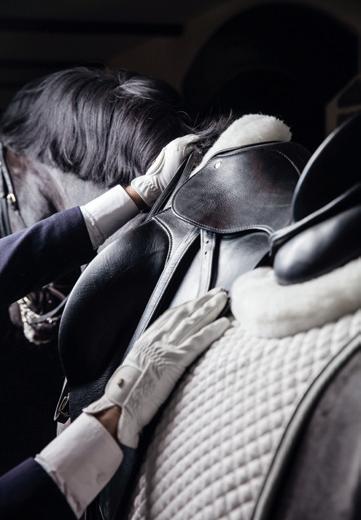
• Behavioural changes – e.g. bucking; bolting; girthy; biting; unwillingness to work or maintain impulsion and collection
• Uneven sweat patterns after being worked under saddle (dry patches can highlight impeded circulation due to persistent pressure/pinching)
• Patches of white hair in the saddle area or hair loss (indicative of damage to hair follicles from pressure/rubbing)
• Open sores
• Saddle bridging or rocking or slipping forwards/backwards
•
It is important to fit the saddle for the horse and the rider – a saddle that fits the horse but is the wrong size and shape for the human will usually lead to poor rider position, imbalance, an unsecure seat and ineffective aids. This rider will be negatively influencing the horse’s way of going, likely leading to compensatory muscular and/or joint issues which can be as detrimental as the horse having a saddle
customisable saddles mean that – so long as the person adjusting them is experienced –the horse is more likely to remain comfortable in its saddle throughout changes in condition cycle/age etc. than a horse wearing an off-theshelf model with no capability for adjustment.
Foam risers, wedges or shims can be used under the saddle and on top of the saddle pad to balance saddles and prevent rocking/ bridging etc. Again, having a knowledgeable saddle fitter out to the horse to advise on placement of shims is preferable. Shims are often seen with Western saddles since traditionally their trees were more difficult to adjust than the English saddle trees, however this is changing.
Saddles with interchangeable steel gullet plates (also known as an adjustable saddle tree) have divided opinion over the years, however many favour saddles with a synthetic tree and adjustable feature as the gullet (i.e. tree angle) can be changed by the owner themselves, relatively quickly. In some saddles, access to the tree is via the pommel and the gullet plate is swapped out as necessary, in others the width of the gullet is changed using an Allen key and the saddle need not be disassembled. Some Western saddles allow for the width of the bars to be changed in this way. Interchangeable gullets are very useful for the
that does not fit it. Riders should always be monitoring their horse’s demeanour during saddling and when ridden to identify any problems with saddle fit early on.
Sadly, a large proportion of horses in pain because of ill-fitting saddles are labelled as naughty and punished. Many others simply tolerate the discomfort and pain, a reduction in performance perhaps the only indication of their distress. Unfortunately, the incidence of ill-fitting saddles is widespread, due perhaps to the fact that many horse owners are reluctant to have their saddle fit assessed professionally and regularly - at least annually.
Riders owe it to their horses (and themselves) to have saddle fit assessed by a professional, not just when initially purchased but at regular intervals throughout the horse’s life. Horses do not stay the same shape throughout their entire lives, their musculature is constantly changing in response to a myriad of factors such as nutritional status, life stage (young/pregnant or lactating/senior) and exercise level. Maintaining this crucial piece of tack should be done with the same due diligence afforded to farrier, veterinary and dental check-ups.
horse that is growing, or whose body changes over the different seasons. Owners do need to be aware however that by changing the gullet plate they are only influencing the tree point angle and tree width; none of the gullet plates impact on the entire ‘channel’ (gullet) that runs the length of the saddle; this will always remain the same.
